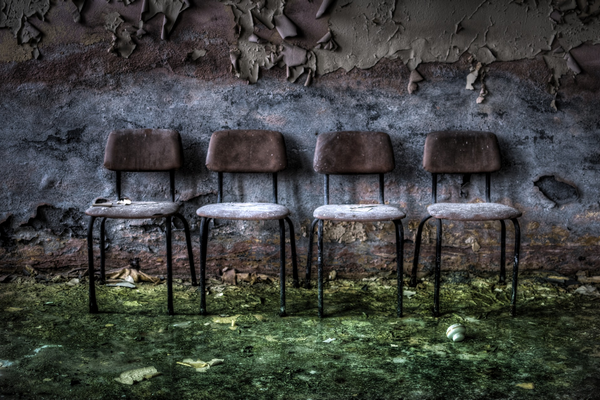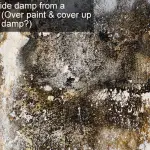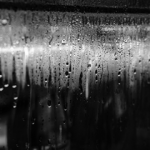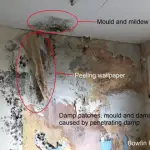
As a part of the mortgage application process, banks and other lenders will usually require a property survey be carried out. This survey will pickup if there any damp problems with the house you’re looking to buy. This can lead to a mortgage refused due to damp.
But what to do if your mortgage is refused due to damp? If you’ve had a mortgage refused due to damp the damp issue must be quite severe, as most lenders tend to down-value a property with damp. The surveyor will assess the damp problem and associated costs to fix it for the lender to downgrade the mortgage. Either renegotiate the price or ask the vendor to fix the problem.
What happens if mortgage application gets rejected due to damp problems?
As already explained, it’s unusual for a lender to reject your mortgage application on the basis of a damp problem. But if the damp problem is very severe, this may result in a complete rejection.
However, if this is the case you are very likely to know of the problem when you viewed the house. Whilst you may not appreciate the full extent of the damp related problems, the damp in this type of situation will very likely be visible.
So let’s take a look at what could lead to being rejected on your mortgage application due to damp.
Mortgage declined after survey and what can lead to a mortgage refused due to damp?
In certain situations where rising damp has gone beyond the stained plaster and pealing paint is when a lender may refuse to lend. If the damp has been left so long that the building timbers are now decaying and is causing structural problems with the house, this will result in a mortgage refusal.
Most lenders lend on the basis that a house must be habitable. This means for a start it must have a kitchen, a working bathroom and running water. But if the damp problem is so severe that it is this that renders the house uninhabitable, you may struggle to borrow in the conventional way.
The reason for this approach by the lender is they are thinking from the viewpoint of needing a quick sale upon repossession. For this the kitchen and bathroom are very important.
If you intend to buy a house to renovate, but it’s not habitable for the ‘normal’ person, you may need to resort to specialist lending, like bridging finance. The bridging finance will provide the time to fix the problems, before switching to a longer term lending solution on a conventional mortgage.
All this being said, the price of property you are buying with the severe damp problems needs to reflect the works that is needed to rectify the problems associate with the damp problems.
Solutions for mortgage declined after survey due to damp
If you find yourself in the situation where the damp problem is so severe the mortgage has been declined, what are you options? This could include the following:
- Try to renegotiate with the lender: If the damp is so severe the lender has refused to lend, it’s unlikely they will reconsider the decision.
- Find another lender: You could try to find another mortgage lender who might lend on the property with the damp problems as they are. But you could waste a lot of time doing this, which could result in you losing the property to another bidder.
- Speak to a mortgage broker: I always use a mortgage broker for my property lending, as they will know which lenders will lend on specific propositions. You may find a broker is able to find a lender willing to lend on the property in its current state.
- Seek specialist lending like bridging finance: Bridging companies often take a different approach to lending on properties that require significant work to restore them to a normal lending state.
Other mortgage problems caused by damp issues found on a survey
What normally happens when the survey picks up damp is the lender will downgrade the valuation by the cost to rectify the damp problem. This may not be what you were hoping for and if you don’t have sufficient deposit to cover the difference, this could scupper the deal.
But also the lender can put a retention on your mortgage. A retention means the lender will withhold an amount equal to what it will cost to fix the damp problem. This may also cause you problems with proceeding if you don;t have sufficient funds to cover the shortfall.
In this scenario it’s more than likely you were not aware of the damp problem when you viewed the house you’re looking to buy. But this will depend on how severe the damp is. Plus on how much the damp is visible on the walls in the house. At this point and either way you have a choice.
What to do if your mortgage company has put a retention or downgraded the mortgage due to damp?
If the survey has picked up on a damp problem, you have a few options as follows:
- Renegotiate the price with the vendor: Often times when you negotiate and offer you are not aware of any problems that may get picked up on survey. You should then use the results of the survey as a bargaining chip to reduce the offer price accordingly.
- Ask the vendor to fix the damp problem: One of the best solution is to request that the vendor fix the damp problem before you go ahead with the purchase. Ideally you want to get this done before exchange of contracts. This is a less risky option and gives time for the works to be completed. But make sure to insist on a damp proof guarantee of the completed works.
- Renegotiate the retention or mortgage downgrade: Often times the mortgage company will over estimate the amount of the retention or mortgage downgrade. If this is the case, you should speak with your mortgage lender to renegotiate the retention or downgrade amount.
- Change mortgage lenders: You could try another lender to see if you can find one that will lend 100% of the loan based on the state of the house. But this will result in delays and more costs associated with another survey and is unlikely to give you a different result.
- Miss-diagnosis of rising damp: It’s possible for the cause of the damp to be miss-diagnosed. There a many arguments about the existence of rising damp and can sometimes be confused with condensation. You could therefore seek a second opinion on the damp problem raised.
What are the types of dampness in building?
There are three types of dampness in buildings, which include:
- Condensation: The most common form of damp caused by moisture in the air and bad ventilation.
- Penetrating damp: Caused by rain that gets in through the gaps in brickwork, the roof, windows or doors.
- Rising damp: Affects the walls on the ground floor and basements and occurs due to faulty or bad damp proofing.
- Plumbing problems: Defects in the plumbing with leaking pipes in a property can also lead to damp related problems.
1. Condensation damp
Condensation damp isn’t actually damp, it is condensation from moisture vapour in the house. You often find condensation damp in bathrooms with poor ventilation.
It would be unlikely for a mortgage refusal due to a condensation issue.
Other factors that can cause condensation in a home include cooking and the steam from around the cooker. Clothes dryers that are not properly ventilated to the outside in laundry rooms often cause condensation.
The cause of condensation damp is when the air-borne moisture falls onto a cold surface. This is normally a wall and often on the inside of an outside wall.
The solution for condensation damp is first to reduce the amount of moisture where possible. But then to improve ventilation using adequate extraction.
Condensation is noticeable by the black mould that forms from the moisture on the walls.
2. Penetrating damp (or structural damp)
Penetrating damp or structural damp is more serious that condensation. It can cause some major problems in a house if left unchecked.
The term penetrating is damp used to describe all forms of damp that enters the property from outside. This can be caused by a number of problems in a property.
Penetrating damp can be caused by defective mortar between the bricks. It can also be a problem with the cavity between the outer wall and inner wall. This is called bridging. This is where debris can fill the cavity and bridge the gap between and let water leak into the property.
The property may also have problems with the outside render where cracks can cause water ingress.
Other defects include lost roof tiles and a damage to the felt. Or on a thatch property the old thatch leaks and is in need of repair. You can also find problems around chimneys and the flashing’s around these, or in the gullies in the roof.
Additionally, the gutters and down pipes can cause water ingress which leads to damp problems in the property.
3. Rising damp
Rising damp is a type of damp that affects the walls of buildings. It happens when moisture from underground travels by capillary action up through the walls. This ‘sucked-up’ water will further penetrate other materials in the property. This includes plaster and timber including floor joists, skirting and floor boards.
As the water rises up in the walls, salts are also drawn up. The result are visible signs of the damp. This is when the plaster begin to stain and the salts begin to crystallise on the outside of the plaster.
Rising damp can be cause due to a problem with the damp proof course (DPC) if the property has one. Older properties were built without a DPC. Other solutions have been used to resolve any rising damp issues like injecting the wall with a damp course.
Other causes is where the damp proof course is in tact, but where the DPC has been bridged. This is where water is able to travel up past the DPC. It can happen if earth on the outside of the property is built-up above the line of the damp course.
4. Plumbing problems
If the property has had a leaking pipe for some time, this can lead to damp problems. If a leaking pipe is allowed to go unnoticed and the damp gets into the timbers, this could result in the rotting of joists and floor boards.
What is more common is for waste pipes or over flows to go unnoticed for a while until there’s been significant hidden damage done.
Arguably, you could include in this category defects in the guttering and external rain pipes too.
In conclusion, it always pays to have a survey done on the house you are buying. Don’t see the mortgage refusal due to damp as a negative. It may just have saved you thousands of Pounds in repair costs post completion!
What are the problems with buying a house with damp issues?
Damp problems will put many buyers off, but the problem is it’s often not visible and only becomes apparent after a survey.
Depending on the type of damp problem there is will depend on your decision on continuing with the property purchase. Let’s look at this in relation to the above types of damp, as follows:
1. Should you buy a house with condensation damp?
The least problematic damp could be argued to be condensation damp. The reason for this is how easy it is to fix. for example, condensation in a bathroom or a kitchen is usually due to bad ventialtion and a lack of decent extraction.
Ventilation and extraction is an easy fix and a very low cost repair to any property.
However, you may want to speak with a suitably qualified builder who can assess the problem and quote for the cost to fix the problem.
This will probably mean you’ll have to redecorate the offending room, which will add to the cost of repair. But this cost will be relatively low and an easy fix post purchase.
2. Should you buy a house with penetrating or structural damp?
If the penetrating or structural damp hasn’t caused any related problems, for example rotting timbers and such like, these can be fixed and the damp problem goes away immediately.
However, the cost of this type of repair can be more expensive than a simple moisture problem. For example, if its a structural leak due to a defective roof, this needs to be checked by a builder.
But if the penetrating damp has caused other related problems with the house, this is a different matter and could even lead to a mortgage refusal in any case.
If you are not inclined to take on a project and fix a damp problem after of this nature after you’ve moved in, your solution is to ask the vendor to fix the problem before you purchase.
However, if they are not inclined to pay for the repair, you have a choice. You either walk away and find another property, or you renegotiate the purchase price.
3. Should you purchase property with rising damp?
The answer to should you purchase property with rising damp depends on the severity of the problem and on your appetite to fix the problem after your purchase.
Assuming the mortgage isn’t refused due to damp, you will need to assess what has been highlighted on the surveyors report. Depending on the extent of the problem and the cause of the damp issue, you may be better to ask the vendor to fix the problem before exchange of contracts. This type of fix can be expensive.
However, if the vendor is not happy to do the work, you are better to get a quote for the work and renegotiate the purchase price to reflect the cost of the works.
But don’t buy a house with a rising damp problem if you’ve not got a quote for the cost of the works and renegotiate the price or got the buyer to do the works first. But make sure they vendor uses a reputable damp repair specialist who offer an insurance-backed guarantee.
If neither of these are an option, you will need to walk away from the deal and begin your house search once more.
4. Should you buy a house with plumbing problems that are causing damp issues?
The answer to this question is; it depends. It depends on your propensity to want to take on a project and on the severity of the related plumbing related problem.
But it also depends upon whether or not the plumbing problem has cause other related problems with the property. I would suggest you get a builder in to assess the problem and the related damage and quote for the work.
You then have a choice. Either renegotiate the price to take account of the cost of works. Or you ask the vendor to remedy the problem before you buy. If neither are acceptable to you or the vendor refuses, you are back to searching for a new home again.
I hope you’ve enjoyed this article about mortgage refused due to damp
If you’ve enjoyed this article about mortgage refused due to damp please share it on your favourite social media site.
Also, if you have any questions, please feel free to comment below too. Alternatively, if you need more help, please feel free to contact us on our contact us page here. Or join the discussion and ask your question in the property forum.




